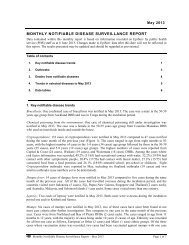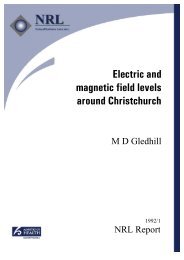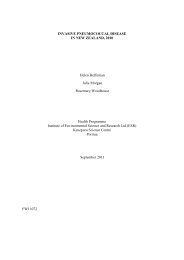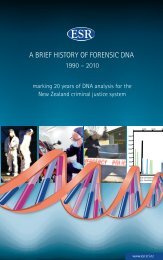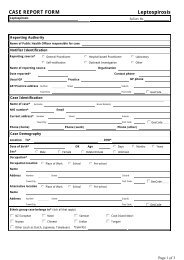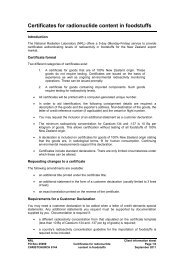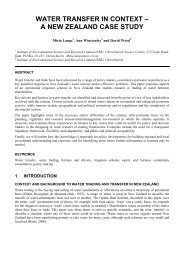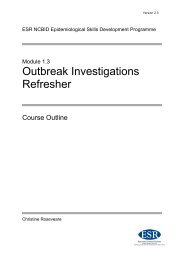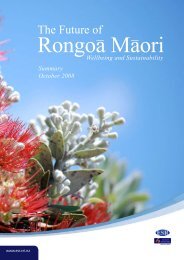environmental health indicators for new zealand: feasibility study
environmental health indicators for new zealand: feasibility study
environmental health indicators for new zealand: feasibility study
Create successful ePaper yourself
Turn your PDF publications into a flip-book with our unique Google optimized e-Paper software.
ENVIRONMENTAL HEALTHINDICATORS FORNEW ZEALAND 2002Prepared as part of a Ministry of Healthcontract <strong>for</strong> scientific servicesbyRabia KhanResearcherPopulation & Environmental HealthESROctober 2002Client Report
ENVIRONMENTAL HEALTHINDICATORS FORNEW ZEALAND 2002David PhillipsPopulation & Environmental Health Programme ManagerRabia KhanProject LeaderPeer Reviewer
DISCLAIMERThis report or document (“the Report”) is provided by the Institute of EnvironmentalScience and Research Limited (“ESR”) solely <strong>for</strong> the benefit of the Ministry of Health,District Health Boards and other Third Party Beneficiaries as defined in the Contractbetween ESR and the Ministry of Health. It is strictly subject to the conditions laid outin that Contract.Neither ESR, nor any of its employees, makes any warranty, express or implied, orassumes any legal liability or responsibility <strong>for</strong> use of the Report or its contents by anyother person or organisation.Environmental Health Indicators i 18 December 2003<strong>for</strong> New Zealand
Table of ContentsSUMMARY................................................................................................................. iii1. INTRODUCTION .............................................................................................42. BACKGROUND ...............................................................................................53. METHODS ........................................................................................................74. FINDINGS .........................................................................................................94.1 Ambient Air Quality ..........................................................................................94.2 Indoor Air Quality............................................................................................114.3 Housing and Settlements..................................................................................124.4 Traffic Accidents..............................................................................................134.5 Noise ................................................................................................................144.6 Waste and Contaminated Lands.......................................................................154.7 Radiation ..........................................................................................................174.8 Water (Drinking and Recreational) and Sanitation..........................................184.9 Food safety.......................................................................................................214.10 Chemical Emergencies.....................................................................................224.11 Workplace ........................................................................................................245. DISCUSSION ..................................................................................................265.1 General .............................................................................................................265.2 Data Availability..............................................................................................265.3 Data Quality .....................................................................................................275.4 Data Usefulness................................................................................................275.5 Relationship to Other Initiatives ......................................................................28Environmental Health Indicators ii 18 December 2003<strong>for</strong> New Zealand
SUMMARYThis report was commissioned by the Ministry of Health under the 2001/2 ESR/MoH<strong>environmental</strong> <strong>health</strong> work programme. The goal of the project is to develop anational core set of <strong>environmental</strong> <strong>health</strong> <strong>indicators</strong> [EHI’s] <strong>for</strong> New Zealand. Thisreport assesses the WHO recommended core and extended set of <strong>indicators</strong> and itsapplicability in the New Zealand context.A <strong>feasibility</strong> <strong>study</strong> assessing the availability, quality and usefulness of each indicatorwas conducted. The findings of this <strong>study</strong> suggest that there is a wealth of<strong>environmental</strong> <strong>health</strong> data being collected in New Zealand by a myriad o<strong>for</strong>ganisations. Hence, no <strong>new</strong> monitoring systems need to be developed. However,there needs to be a more concerted ef<strong>for</strong>t at extracting the relevant data from existingsystems and trans<strong>for</strong>ming it to summarised, accessible in<strong>for</strong>mation <strong>for</strong> <strong>environmental</strong><strong>health</strong> decision making. At present, we have found that 70% of the total (core andextended) WHO <strong>indicators</strong> are available in New Zealand.There are many benefits to be gained from the establishment of an <strong>environmental</strong><strong>health</strong> indicator system, including the ability to benchmark internationally andpromote multi-agency networking to facilitate data exchange. The EH <strong>indicators</strong>ystem can provide an integrated assessment of progress on selected issues relevant tosustainable development, especially in the context of human <strong>health</strong>. Areas of greaterrelative need can be identified objectively using EHIs in order to facilitate the settingof EH policy priorities. Data systems cannot replace policies and actions directlyaimed at improving <strong>environmental</strong> <strong>health</strong> conditions but they could nonetheless <strong>for</strong>man intrinsic part of the decision making process at early stages.Environmental Health Indicators iii 18 December 2003<strong>for</strong> New Zealand
1. INTRODUCTIONThe goal of the project as articulated in the service description is to develop a functional coreset of <strong>environmental</strong> <strong>health</strong> <strong>indicators</strong> [EHI’s] <strong>for</strong> New Zealand, the major outcome being afunctional interactive database, incorporating multiple data sets providing timely data todifferent organisations <strong>for</strong> decision making.This process as outlined in the previous report [FW0192] has two principal phases, namely:I. Creation of base line dataset in environment <strong>health</strong>:• Literature review of frameworks• Audit and report on current available dataII. Construction of a prototype set of <strong>environmental</strong> <strong>health</strong> <strong>indicators</strong>:• Design a model database of <strong>indicators</strong>• Identify key issues in consultation with an expert panelThe previous report addressed phase I above recommending the adoption of the WHO-Europe DPSEEA Indicators framework. This report uses that framework to address thefollowing milestones in the 2002/3-service description:• Form project working group and map stakeholder needs and activities. Consult onidentified existing and missing data sources and data quality issues within theEnvironmental Health Strategy framework.• Describe elements, structure, and process of a national <strong>environmental</strong> <strong>health</strong> <strong>indicators</strong>ystem in consultation with the MoH service description leader, including proposed<strong>indicators</strong> <strong>for</strong> New Zealand based on the WHO model but incorporating NZ priorities,existing data sources, and data gaps, and including incorporating appropriaterecommendations of the Public Health Advisory Committee when available.Specifically this report:• Critically reviews the WHO indicator sets from a New Zealand perspective.• Determines the gaps in the NZ data with respect to the WHO dataset.• If appropriate, suggests alternative <strong>indicators</strong> and data sets.• Describes key elements of the next phase of the work. .Environmental Health Indicators 4 18 December 2003<strong>for</strong> New Zealand
2. BACKGROUNDAgenda 21 is a comprehensive plan of action adopted by more than 178 Governments at theUnited Nations Conference on Environment and Development (UNCED) held in Rio deJaneiro, Brazil, 3 to 14 June 1992. It explicitly identifies the inter-relationships of human<strong>health</strong>, the environment and development, and the need to improve <strong>health</strong> in order to achievesustainable development. Thereby providing an internationally agreed framework <strong>for</strong>embedding both <strong>environmental</strong> and <strong>health</strong> in<strong>for</strong>mation in the broader context of sustainabledevelopment.To meet this goal, development policies and programmes need access to quality data andin<strong>for</strong>mation on these differing areas, based on a clear understanding of the underpinninginter-relationships.In most countries, responsibilities <strong>for</strong> the collection, collation, and analysis of environmentand population <strong>health</strong> data are spread among different agencies, and the links between <strong>health</strong>effects and potential <strong>environmental</strong> impacts are rarely explicit. As a consequencepreventative/remediation actions are initiated with insufficient evidence.To help this, WHO-Europe have instigated a project to develop and test a pan-Europeansystem of <strong>environmental</strong> <strong>health</strong> <strong>indicators</strong> covering all the principal [physical] <strong>environmental</strong>issues of human <strong>health</strong> relevance. Initiated in October 1999 and aimed originally at theestablishment of a comprehensive EH monitoring system within the NEHAP framework andit has resulted in a proposed common “core” set of <strong>environmental</strong> <strong>health</strong> <strong>indicators</strong> and aprotocol <strong>for</strong> their pilot testing in selected countries. Eleven <strong>environmental</strong> themes wereidentified :• Air quality,• Housing,• Traffic accidents,• Noise,• Waste and contaminated lands,• Radiation,• Water and sanitation,• Food safety,• Chemical emergencies, and• Workplace.and subsequently a set of 51 “core” <strong>indicators</strong> derived <strong>for</strong> international assessments.Most of the core <strong>indicators</strong> are also applicable <strong>for</strong> use at a subnational level. The core set isthat which all countries would have the available data whereas an extended set is alsoproposed <strong>for</strong> countries with more developed monitoring systems.Environmental Health Indicators 5 18 December 2003<strong>for</strong> New Zealand
The revised <strong>indicators</strong> system, after the pilot evaluation, will be recommended <strong>for</strong>implementation in the European region of the WHO. The objective of the program is thedevelopment of tools to support decision-makers focussing on the establishment of acomprehensive, <strong>environmental</strong> <strong>health</strong> <strong>indicators</strong> system <strong>for</strong> integrated assessment andreporting based on comparable datasets.A number of criteria and choices were considered in defining operational <strong>indicators</strong>. Thecommonly accepted cause-effect framework, DPSEEA (Driving <strong>for</strong>ces – Pressures – State –Exposure – Effect – Action) was used. The scope of the <strong>indicators</strong> system was conceived tocover mainly the state of environment, population exposure, <strong>health</strong> outcomes, and to a lesserextent – pressures and driving <strong>for</strong>ces.Criteria <strong>for</strong> the selection of the <strong>indicators</strong> included sufficient evidence <strong>for</strong> a valid<strong>environmental</strong> exposure to <strong>health</strong> outcome relationship and more general ones, eg. validity,sensitivity, timeliness, etc. Nevertheless, it was acknowledged that some areas, eg. indoor air,noise, water quality, etc would require implementation of <strong>new</strong>methods <strong>for</strong> data gathering.A number of <strong>indicators</strong> representing <strong>health</strong> protection measures and intersectoral policiesactions are included to permit decision-makers to focus on specific action areas. The<strong>indicators</strong> are based as far as possible on routinely collected data from existing systems.The consultation emphasised that in, and between, country differences do not allow theselection of one, “universally” applicable indicator set. Although initially conceived to beused <strong>for</strong> monitoring NEHAP implementation, the currently developed <strong>indicators</strong> are useful,more generally, <strong>for</strong> monitoring <strong>environmental</strong> <strong>health</strong> policies and programs. Selection of botha core and a more extended set allows individual countries greater flexibility in their use. Thecore set enables inter-country comparisons while the extended set can be customised <strong>for</strong>country specific reports.It is important to note that although the fundamental inter-relationship between<strong>environmental</strong> exposure and <strong>health</strong> effects, is in the majority of cases well recognised (e.g.air quality and respiratory mortality or morbidity), <strong>health</strong> outcomes are influenced by avariety of factors, among which <strong>environmental</strong> exposures may not be the most importantones. Thus the assessment of single <strong>health</strong> outcomes (e.g. infant mortality due to respiratorydisease) does not allow direct causal inference to <strong>environmental</strong> exposures.The population attributable risk, where available, is a useful tool of assessing how much ofthe disease burden could be eliminated if the exposure were eliminated. The populationattributable risk of the percentage of deaths and DALY’s globally attributable to theenvironment is 25-33% and 6% respectively. 1 2 A recent <strong>study</strong> calculated that the US federalgovernment heath care costs attributable to the environment were estimated to be 13.5 billiondollars, using a mean attributable percentage of 3.5%. 3 Knowledge of the disease burdencaused by <strong>environmental</strong> exposures, and its use in <strong>health</strong> impact assessment can be extremelyuseful in guiding policy choices in <strong>environmental</strong> <strong>health</strong> management.1 Michaud Catherine M, Murray CJL, Bloom BR. Burden of disease- implications <strong>for</strong> future research. Journal ofthe American Medical Association, 2001; 285: 535-9.2 Smith KR, Corvalan CF, Kjellstrom T. How much global ill <strong>health</strong> is attributable to <strong>environmental</strong> factors?Epidemiology, 1999; 10: 573-84.3 Public Health Foundation. Return on investment of nationwide <strong>health</strong> tracking. Washington, D.C.,2001.Environmental Health Indicators 6 18 December 2003<strong>for</strong> New Zealand
3. METHODSA standardised protocol was agreed upon by WHO to facilitate the <strong>feasibility</strong> and evaluationof the <strong>indicators</strong> both at a national and multi national level. Details of the methodology canbe found at: http://www.euro.who.int/EH<strong>indicators</strong>Using the WHO template, a questionnaire was filled out <strong>for</strong> each indicator. Three differentquestionnaires corresponding to the respective indicator sets (<strong>health</strong>; <strong>environmental</strong>; action)were used to identify:• source• reliability,• quality,• spatial resolution,• degrees of aggregation and,• geographical coverage.Relevant in<strong>for</strong>mation was collected by telephone interviews, e-mails, personalcommunication and literature reviews from the relevant sources in NZ.The following dimensions of the data were assessed:• Feasibility: is the indicator generally feasible or not, i.e. is the data available or can thedata be collected/collated or not?• Usefulness: is the indicator useful to support decision making?• Possible modification of indicator: is data available on a modified <strong>for</strong>m of the indicator?• Alternative indicator: is there a more relevant indicator <strong>for</strong> New Zealand ?• Availability: what ‘work’ is needed to obtain the required data <strong>for</strong> the variables?• Accessibility: at what ‘level’ of an organisation can the data be collected?• Data quality: is standardised methodology <strong>for</strong> data collection and quality assurancesystem in placeA coding system was developed by WHO as part of the <strong>feasibility</strong> <strong>study</strong>. It should be notedthat the criteria <strong>for</strong> both quality and usefulness are to a certain degree subjective and reflectthe author’s personal assessment and that of data/stakeholders consulted in the process. Theseassessments are preliminary and it is proposed to refine the process during subsequentconsultation using a Delphic process.Availability, is the data is collected at national level? The gradations are.0: currently not available at national level1: currently not available, but derivable from other sources2: availableQuality, of the data, represents whether there is a quality assurance/control system in placeand the use of standardised methodology <strong>for</strong> data collection.1: neither in place2: either one in place3: both in placeEnvironmental Health Indicators 7 18 December 2003<strong>for</strong> New Zealand
Usefulness, Can the indicator be used <strong>for</strong> comparisons, related to a policy objective or toexisting standards and has it utility within the New Zealand context.1: not useful2: some utility3: very usefulThe results are structured by topic, namely:• Air quality,• Housing,• Traffic accidents,• Noise,• Waste and contaminated lands,• Radiation,• Water and sanitation,• Food safety,• Chemical emergencies, and• Workplace.The <strong>indicators</strong> within these topics are either• Environmental <strong>indicators</strong>: describing a driving <strong>for</strong>ce, pressure, state or exposure• Health <strong>indicators</strong>: describing the <strong>health</strong> effect or,• Action <strong>indicators</strong>: describing organisational or societal (re)actions.The results are summarised in the following section with tables <strong>for</strong> each topic.Environmental Health Indicators 8 18 December 2003<strong>for</strong> New Zealand
4. FINDINGS4.1 Ambient Air QualityTable 1 : Air Quality IndicatorsCode Indicator Availability0-2Quality1-3Usefulness1-3Air_D1 Kilometres driven per transport mode per person 2 3 3Air_D2 Consumption of fuel by type from road transport 1 2 3Air_P1 Consumption of leaded gasoline 0 N/A N/AAir_P2 Emissions of air pollutants 2 2 3Air_Ex1 Ambient concentrations of air pollutants (urban): population-based 2 2 3exposureAir_E1 Infant mortality due to respiratory diseases 2 3 3Air_E2 Mortality due to respiratory diseases, all ages 2 3 3Air_E3 Mortality due to diseases of the circulatory system, all ages 2 3 3Air_A1 Participation in International agreements and <strong>environmental</strong> initiatives 2 3 1Air_A2 Policies to reduce <strong>environmental</strong> tobacco smoke exposure 2 3 3Air_ext1 Emissions of Lead, primary PM10, NO x and benzene in urban regions 1 1 3Air_ext2 Number of hospital admissions <strong>for</strong> respiratory diseases. 2 3 3Air_ext3 Number of hospital admissions <strong>for</strong> asthma 2 3 3Air_ext4 Number of hospital admissions <strong>for</strong> diseases of the circulatory system 2 3 3Air_ext5 DALY due to morbidity and mortality as a result of ambient air 0 N/A 3pollutionAir_ext6 Investments in transport infrastructure 0 N/A 24.1.1 Environmental IndicatorsAir_D1: Kilometres driven per transport mode per personAvailability: Available from Ministry of Transport using the National Traffic Database from1979 to 2000Usefulness: The impact of policies targeted at reducing the traffic as significant source of airpollution and noise can be usefully assessed.Quality: Being modelled data, values need to be interpreted with caution.Air_D2: Consumption of fuel by type from road transportAvailability: Available from the Ministry of Economic Development and StatsNZ from 1990-2000.Usefulness: Can be interpreted in terms of a measure of potential emission of air pollutants.Quality: The numbers are estimates and represent modelled dataAir_P1 : Consumption of leaded gasolineAvailability: Not relevant since leaded gasoline is banned in New Zealand.Usefulness: N/AQuality: N/AAir_P2 : Emissions of air pollutants by economic sectorsAvailability: Available from NIWA. First available 1996, reviewed annually, and revisedevery five years. Some regional councils have conducted more detailed emissions inventory<strong>for</strong> their regions, which are revised every five years.Usefulness: Can be used to interpret temporal trends in air pollution emissions.Quality: National emission data are estimates based on overseas data and adjusted <strong>for</strong> NewZealand.Environmental Health Indicators 9 18 December 2003<strong>for</strong> New Zealand
Air_Ex1: Ambient concentrations of air pollutants (urban): population-based) NO 2 , PM 10 ,SO 2 ,PM 10 , TSP, Black smoke, O 3 .)Availability: Data available from MfE, regional councils and NIWA from 1990- 2002Usefulness: Can be used to interpret both spatial patterns and temporal trends in air pollutionexposure.Quality: Not all the pollutants that make up the indicator are monitored at all sites and eachregional council measures slightly different pollutants. Number of sampling sites variesbetween different regional councils. Different sampling techniques are being used to measurePM10 throughout the country.Comment: MfE is currently working on standardising measuring and reporting techniques.4.1.2 Health IndicatorsAir_E1: Infant mortality due to respiratory diseasesAvailability: Available from NZHIS from 1973 to 1998.Usefulness: Shows temporal trends which, using appropriate epidemiological evidence canbe correlated with local levels of ambient air pollution.Quality: Complete, but limited in timeliness. The most recent official national mortality dataavailable are <strong>for</strong> 1998 although ‘unofficial’ data are available annually.Air_E2 : Mortality due to respiratory diseases, all agesAvailability: Available from NZHIS from 1973 to 1998Usefulness: As per Air E_1Quality: As per Air E_1Air_E3 : Mortality due to diseases of the circulatory system, all agesAvailability: Available from NZHIS from 1973 to 1998Usefulness: As per Air E-1Quality: As per Air E_14.1.3 Action IndicatorsAir_A1 : Participation in International agreements and <strong>environmental</strong> initiativesAvailability: In<strong>for</strong>mation on ratification available from central government.Usefulness: Shows a countries commitment to the (inter-) national community and enablesthe public to view international goals and targets.Comment: Compliance with these agreements and achievement of goals would be moreuseful.Air_A2 : Policies to reduce <strong>environmental</strong> tobacco smoke exposureAvailability: Legislation exists in the <strong>for</strong>m of the Smokefree ActUsefulness: Provides a general measure of the capability to implement the relevant policies.Comment: An indicator on actual passive smoking exposure would better help understandthe relevance of action in this field.Environmental Health Indicators 10 18 December 2003<strong>for</strong> New Zealand
4.1.4 Extended Set IndicatorsAir_ext1: Emissions of Lead, primary PM10, NO x and benzene in urban regionsAvailability: Available <strong>for</strong> some urban areas from their respective TLA’s but there is no dataon emissions of benzene or primary PM10. Lead and NOx is available <strong>for</strong> Christchurch,Auckland and WaikatoQuality: Variable, as different monitoring methodologies are usedComment: One of the proposed MfE <strong>indicators</strong> is national annual ambient benzeneconcentration.Air_ext2-4: Number of hospital admissions <strong>for</strong> respiratory diseases / asthma / diseases of thecirculatory systemAvailability: Available from NZHIS from 1967-2002, updated quarterly.Quality: Data are counts of the episodes of inpatient care rather than individual people.Air_ext5: DALY due to morbidity and mortality as a result of ambient air pollutionAvailability: Not availableUsefulness: Potentially more useful than proposed core <strong>health</strong> <strong>indicators</strong> as incorporatesdisability, morbidity and mortality into one index.Air_ext4: Investments in transport infrastructureAvailability: Not available.Usefulness: Potentially a measure of commitment to decrease transport related pollution4.2 Indoor Air QualityTable 2: Indoor Air Quality IndicatorsCode Indicator Availability0-2Quality1-3Usefulness1-3INAIR_ext1 Proportion of residences having a moisture problem, visible 0 N/A 3mould or mould odourINAIR_ext2 Proportion of residences exceeding indoor air radon 2 2 2concentration of 200Bq/m3INAIR_ext3 Sources of indoor pollution 2 3 3INAIR_ext4 Consumption of tobacco products 2 2 3INAIR_ext5 Capability to implement indoor air quality management. 2 2 2There is no core set of <strong>indicators</strong> <strong>for</strong> indoor air quality, as data at a national level on indoorair quality is lacking in most countries, including New Zealand.INAIR_ext1: Proportion of residences having a moisture problem, visible mould or mouldodourAvailability: Currently unavailable.Comment: StatsNZ is currently developing a housing <strong>indicators</strong> project. Proposed <strong>indicators</strong>including indoor housing humidity factors (such as dampness, mould, moisture stains, andmusty smells).INAIR_ext2: Proportion of residences exceeding indoor air radon concentration of 200Bq/m3Availability: NRL did a national survey in 1986/87.Usefulness:Quality: Good coverage but now dated.Environmental Health Indicators 11 18 December 2003<strong>for</strong> New Zealand
Comment: There was no evidence of any "hot spots" such as have been found overseas.There<strong>for</strong>e, this indicator may not be relevant to the NZ environment.INAIR_ext3: Sources of indoor pollutionAvailability: Available from StatsNZ as part of census data from 1986-2001.Usefulness: Measure of potential exposure to pollutants in the home.Quality: There have been variations to the question over the years.INAIR_ext4: Consumption of tobacco productsAvailability: Available from StatsNZ, from June 1998 to 2001.Usefulness: Useful in tracking trends in consumption.Quality: Updated annually.Comment: Would benefit from being able to disaggregate by groups reflecting consumptionpatterns, and estimates of number of household members exposedINAIR_ext5: Capability to implement indoor air quality managementAvailability: Available from various sources incl. Public Health Units, BRANZ and MoHUsefulness: Provides a general measure of the capability to implement policies <strong>for</strong> improvingindoor air quality4.3 Housing and SettlementsTable 3 : Housing IndicatorsCode Indicator Availability0-2Quality1-3Usefulness1-3Hous_S1 Living floor area per person 1 3 3Hous_Ex1 Population living in substandard housing 1 2 3Hous_E1 Mortality due to external causes in children under 5 years of age 2 3 2Hous_A1 Scope and application of building regulations <strong>for</strong> housing 1 3 3Hous_A2 Land use and urban planning regulations 1 3 3Hous_ext1 Percentage of the population that has no permanent domicile 2 2 2Hous_ext2 Incidence of asthma incl. LRI in children 2 2 34.3.1 Environmental IndicatorsHous_S1: Living floor area per personAvailability: Can be calculated using census data from 1991-2001.Usefulness: Needs to be interpreted with caution as the relation between the size of the livingarea and <strong>health</strong> status depends on a number of factors.Quality: Available every 5 years.Comment: A better indicator could be the ‘percentage of people in private dwellings livingin crowded households’ (currently available from StatsNZ). Stats NZ has two relevant<strong>indicators</strong> as part of their housing indicator project namely, occupancy rate and equalisedcrowding index.Hous_Ex1: Population living in substandard housingAvailability: Data on populations living in substandard housing is currently being developedas part of the interagency work on substandard housing and should be available from theMinistry of Social PolicyEnvironmental Health Indicators 12 18 December 2003<strong>for</strong> New Zealand
Usefulness: Provides a measure of the condition of the housing stock, it can indicate the<strong>health</strong> risks associated with basic sanitation, poor sanitation, exposures to indoor airpollution, and access to safe waterQuality: Not representative of national data.4.3.2 Health IndicatorsHous_E1: Mortality due to external causes in children under 5 years of ageAvailability: Available from NZHIS from 1973-1998.Usefulness: Can be interpreted as a measure of the hazards in the external environment, butis not specific to the domestic situation.Quality: Good quality but limited timeliness. Unofficial data available annuallyComment: More useful to include specific event rates, e.g. meningococcal, tuberculosis ratesor deaths/injury from fires, as they are better <strong>indicators</strong> of overcrowding.4.3.3 Action IndicatorsHous_A1, A2: Scope and application of building regulations <strong>for</strong> housing / Land use andurban planning regulationsAvailability: Available from TLA’s and the Building Industry Authority.Usefulness: General measure of the scope and application of housing standards and buildingregulations.Comment: Needs to be interpreted with caution, better to measure implementation anden<strong>for</strong>cement.4.3.4 Extended Set IndicatorsHous_ext1: Percentage of the population that has no permanent domicileAvailability: Available from StatsNZ from 1986-2001.Usefulness: Debatable as fluctuates significantly over that time period.Quality: Estimate from census data – every 5 years.Hous_ext2: Incidence of Asthma incl. Lower Respiratory Infection in childrenAvailability: Hospitalisation data available from NZHIS.Usefulness: More useful than other non specific mortality and morbidity dataQuality: Underestimated as based on hospitalisations only, and does not include GP andother <strong>health</strong> provider encounters.4.4 Traffic AccidentsTable 4: Traffic AccidentsCode Indicator Availability0-2Quality1-3Usefulness1-3Traf_E1 Mortality from traffic accidents 2 3 3Traf_E2 Rate of injuries by traffic accidents 2 3 3Traf_ext1 Quality of traffic control 0 NA 2Environmental Health Indicators 13 18 December 2003<strong>for</strong> New Zealand
4.4.1 Health <strong>indicators</strong>Traf_E1: Mortality from traffic accidentsAvailability: Available from LTSA from 1970 to 2002.Usefulness: Relatively easy to interpret, as link between cause and <strong>health</strong> effect is explicit.Quality: Updated monthly.Comment: Changes in the indicator may reflect different factors, e.g. traffic volume, trafficspeeds, access to care.Traf_E2: Rate of injuries by traffic accidentsAvailability: Available from LTSA from 1970 to 2002Usefulness: As per TrafE-1Quality: As per TrafE-1Comment: As per TrafE-14.4.2 Extended Set IndicatorsTraf_ext1: Quality of traffic controlAvailability: Not available.Usefulness: Debatable4.5 NoiseTable 5: Noise IndicatorsCode Indicator Availability0-2Quality1-3Usefulness1-3Noise_E1 Population annoyance by certain sources of noise 0 N/A 3Noise_E2 Sleep disturbance by noise 0 N/A 2Noise_A1Application of regulations, restrictions and noise 1 3 3abatement measuresNoise_ext1 Noise levels distribution 0 N/A 3Noise_ext2No. of people exposed to noise levels above a 0 N/A 3standard in noise level categoriesNoise_ext3No. of people exposed to noise levels >80db(A)(8hr) at work place1 1 34.5.1 Health IndicatorsNoise_E1, E2: Population annoyance by certain sources of noise/ Sleep disturbance by noiseAvailability: Not availableUsefulness: Provides a proxy measure of the long-term <strong>health</strong> effects related to exposure tosome sources of <strong>environmental</strong> noise.Quality: Subjective, episodic and not systematically collected.Comment: There is a proposed citizen noise survey as part of the next quality of life in bigcities publication. Alternative indicator could be the number of noise complaints, which somecity councils keep.Environmental Health Indicators 14 18 December 2003<strong>for</strong> New Zealand
4.5.2 Action IndicatorsNoise_A1: Application of regulations, restrictions and noise abatement measuresAvailability: Available from TLA’s as well as PHU’sUsefulness: This indicator provides a general measure of the capability to implement policies<strong>for</strong> reducing <strong>environmental</strong> noise.Comment: Measures capability rather than en<strong>for</strong>cement or application.4.5.3 Extended Set IndicatorsNoise_ext1: Noise levels distributionAvailability: Not available.Usefulness: Potentially useful in mapping hazard distribution .Noise_ext2: No. of people exposed to noise levels above a standard in noise level categoriesAvailability: Not available.Usefulness: as per Noise_ext1.Noise_ext3: No. of people exposed to noise levels >80db(A) (8hr) at work placeAvailability: Potentially available from OSH.Usefulness: Good direct measure, useful <strong>for</strong> workplace policy and practice.Quality: Coverage not consistent with regard to place or time.4.6 Waste and Contaminated LandsTable 6: Waste and Contaminated Lands IndicatorsCode Indicator Availability0-2Quality1-3Usefulness1-3Waste_P1 Hazardous waste generation 0 N/A 3Waste_S1 Contaminated land area 1 2 3Waste_Ex1 Blood lead level in children 2 2 2Waste_A1 Hazardous waste policies 2 3 3Waste_A2 Municipal waste collection 1 1 2Waste_ext1 Amount of hazardous waste disposed and exported 0 N/A 3Waste_ext2 Existence <strong>for</strong> a register <strong>for</strong> contaminated lands 1 2 34.6.1 Environmental IndicatorsWaste_P1: Hazardous waste generationAvailability: Currently, there is no national registry of hazardous waste. The data on importsof hazardous substances is available from Stats New Zealand. Some regional councils haveconducted hazardous waste surveys.Usefulness: Indicates risk to both the environment and human <strong>health</strong>Quality: Inconsistent in respect of content and time.Comment: One of the proposed MfE <strong>environmental</strong> <strong>indicators</strong> includes the quantity ofhazardous waste generated, stored and discharged.Environmental Health Indicators 15 18 December 2003<strong>for</strong> New Zealand
Waste_S1: Contaminated land areaAvailability: There is no national data regarding contaminated land area but there is data onthe number of contaminated sites <strong>for</strong> each regional council. Available <strong>for</strong> 2000 only fromMfE.Usefulness: Measures the extent of risk posed by contaminated sitesQuality: The data collected by MfE is based on data on sites <strong>for</strong> which records are held.Additional sites may exist <strong>for</strong> which no data is held.Comment: The area of contaminated land can be estimated from the individual regionalcouncil records.4.6.2 Health IndicatorsWaste_E1: Blood lead level in childrenAvailability: Currently only available through the national notifiable disease system.Usefulness: Indicates exposure but only indirectly <strong>health</strong> effectQuality: Not systematically tested <strong>for</strong> and data only available when suspected, tested andnotified.Comment: Population levels can be extrapolated to expected <strong>health</strong> effects4.6.3 Action IndicatorsWaste_A1: Hazardous waste policiesAvailability: Available from ERMA NZUsefulness: Simple, yet reasonably robust measure of the scope, strength and effectiveness ofpolicies and legislation on hazardous wastes.Waste_A2: Municipal waste collectionAvailability: No national data - can be calculated from TLA data.Usefulness: Measures the adequacy of waste removal services.Quality: Variable as no standardised monitoring or reporting system.4.6.4 Extended Set IndicatorsWaste_ext1: Amount of hazardous waste disposed and exportedAvailability: Data on exports of hazardous waste available from Ministry of EconomicDevelopment. There is no data <strong>for</strong> the amount of hazardous waste disposed of.Usefulness: Indicates risk to the environment and human <strong>health</strong>.Quality:Waste_ext2: Existence of a register <strong>for</strong> contaminated landsAvailability: No national data. Some regional councils are coordinating a register ofcontaminated land sites <strong>for</strong> their respective regions.Quality: variable as no standardised methodology used.Usefulness: Provides a general measure of the status of control activitiesEnvironmental Health Indicators 16 18 December 2003<strong>for</strong> New Zealand
4.7 RadiationTable 7: Radiation IndicatorsCode Indicator Availability0-2Quality1-3Usefulness1-3Rad_Ex1 Cumulative radiation dose 2 3 2Rad_Ex2 UV light index 2 3 3Rad_E1 Incidence of skin cancer 2 3 3Rad_A1 Topicality of permits on the use of radioactive 2 3 3substancesRad_A2 Effective <strong>environmental</strong> monitoring of radiationactivity2 3 34.7.1 Environmental IndicatorsRad_Ex1: Cumulative radiation doseAvailability: Available from National Radiation Laboratory.Usefulness: enables estimates of the population exposure.Quality: quality assurance guidelines existComment: a very small proportion of the population receives 5mS per yearRad_Ex2: UV light indexAvailability: Monitored by NIWA and is updated daily <strong>for</strong> three sites i.e. Lauder, Leigh, andInvercargill.Usefulness: Direct measure of the cumulative levels of exposure to UV radiation.Quality: Predicted <strong>for</strong>ecast values modelled on available satellite ozone data.Comment: The relationship between the levels of UV radiation and <strong>health</strong> outcome areconfounded by lifestyle factors (such as sunscreen use).4.7.2 Health IndicatorRad_E1: Incidence of skin cancerAvailability: Available from the cancer registry from 1948 but more complete data from1995 till present.Usefulness: Needs to be interpreted cautiously as an indirect <strong>health</strong> effect of UV exposure.Quality: available annually, complete <strong>for</strong> cases presented and investigated.Comment: Better to focus on specific skin cancers known to be more directly related to UVexposure, eg melanoma and SCC4.7.3 Action IndicatorsRad_A1: Topicality of permits on the use of radioactive substancesAvailability: Available from NRL.Usefulness: provides a measure of the scope and implementation of legislationQuality: quality is maintained through the provisions of the Radiation Protection ActRad_A2: Effective <strong>environmental</strong> monitoring of radiation activityAvailability: Available from NRL.Usefulness: Provides a useful measure of the effectiveness of monitoring activities.Environmental Health Indicators 17 18 December 2003<strong>for</strong> New Zealand
Comment: The indicator does not describe the actual radiation risk but the level ofcompliance with standards.4.8 Water (Drinking and Recreational) and SanitationTable 8: Water and Sanitation IndicatorsCode Indicator Availability0-2Quality1-3Usefulness1-3WatSan_P1 Waste water treatment coverage 2 2 3WatSan_S1 Exceedance of recreational water limit values <strong>for</strong>2 3 3microbiological ParametersWatSan_S2 Exceedance of WHO drinking water guidelines <strong>for</strong>2 2 3microbiological parametersWatSan_S3 Exceedance of WHO drinking water guidelines <strong>for</strong> chemical 2 2 3parametersWatSan_Ex1 Access to safe drinking water 2 3 3WatSan_Ex2 Access to adequate sanitation 1 1 1WatSan_E1 Outbreaks of water-borne diseases 2 2 3WatSan_E2 Diarrhoea morbidity in children 0 N/A 1WatSan_A1 Effective monitoring of recreational water 2 3 3WatSan_ext1 Proportion of coastal or freshwater bathing sites <strong>for</strong>2 3 3recreational use.WatSan_ext2 Mortality rate due to drowning 2 3 3WatSan_ext3 Capability of management of enclosed water generally 1 2 3available <strong>for</strong> bathingWatSan_ext4 Intensity of recreational water quality monitoring 2 3 3WatSan_ext5 Mean and percentile concentrations of selected chemical 2 3 3contaminantsWatSan_ext6 Percentage of population receiving piped water at home. 1 2 2WatSan_ext7 No. of discontinuities of public drinking water supply <strong>for</strong> > 12 1 3 2hours.WatSan_ext8 Number of cases of water borne diseases 2 2 3WatSan_ext9 Intensity of drinking water quality monitoring 2 3 3WatSan_ext10 Capability of water resources quality management 2 3 3WatSan_ext12 Good practice to drinking water management 2 3 34.8.1 Environmental IndicatorsWatSan_P1: Waste water treatment coverageAvailability: Available from ESR [from 2001] and from regional councils, Neptune, WaterIndustry NZ and the Ministry of Economic Development.Usefulness: Measures <strong>environmental</strong> load and <strong>health</strong> risk from exposure to untreated orpartially treated wastewater.Quality: Covers 95% of TLA’s; doesn’t include educational institutes, camping grounds,marae, government organisations and private institutions.WatSan_S1: Exceedance of recreational water limit values <strong>for</strong> microbiological parametersAvailability: Available from Regional Councils, who monitor beach water quality at anumber of sites throughout New Zealand, from November until March and monthly duringthe rest of the year. Data is posted on the MfE website and weekly on the relevant individualcouncil websites during the monitoring period.Usefulness: It is a measure of the microbiological quality of bathing waters.Quality: Councils use standard guidelines developed by MfE and MoH. Different councilsstarted monitoring from different time periods.Environmental Health Indicators 18 18 December 2003<strong>for</strong> New Zealand
WatSan_S1: Exceedance of WHO drinking water guidelines <strong>for</strong> microbiological parametersAvailability: Available from ESR from1991 to 2001.Usefulness: Direct measure of the safety of drinking water [microbiological]Quality: Only 87% of the population water supply is registered, hence there is noin<strong>for</strong>mation on the water quality of the remaining 13%. Updated annuallyWatSan_S2: Exceedance of WHO drinking water guidelines <strong>for</strong> chemical parametersAvailability: Available from ESR from 1986 - updated approximately every five yearsUsefulness: Measure of the state of the drinking water contamination.Quality: same as WatSan_S1WatSan_Ex1: Access to safe drinking waterAvailability: Available from ESR from 1986-2001.Usefulness: Good indicator of <strong>health</strong> risk from unsafe potable water.Quality: Same as WatSan_S1.WatSan_Ex2: Access to adequate sanitationAvailability: Not routinely available but can be obtained with some ef<strong>for</strong>t.Usefulness: Good indicator of access to but not quality of sanitation facilitiesQuality:4.8.2 Health IndicatorsWatSan_E1: Outbreaks of water-borne diseasesAvailability: Available from EpiSurv from 1996 to 2002. The data is updated weekly andpublished monthly.Usefulness: Measure of <strong>health</strong> effects due to exposure to contaminants in water.Quality: Underreporting is common.Comment: Clearly distinguishing between water borne and food borne outbreaks can bedifficult.WatSan_E2: Diarrhoea morbidity in childrenAvailability: Not availableUsefulness: Good measure of <strong>health</strong> status of children, especially under conditions ofinadequate water or food hygiene and basic sanitation. Not envisaged to be very relevant toNZ.Quality: Not systematically collected.Comment: Alternative indicator could be the number of children notified with an entericdisease corrected <strong>for</strong> known levels of underreporting.4.8.3 Action IndicatorWatSan_A1: Effective monitoring of recreational waterAvailability: Available from MfE and regional councilsUsefulness: General measure of local authority control over bathing water safetyEnvironmental Health Indicators 19 18 December 2003<strong>for</strong> New Zealand
4.8.4 Extended Set IndicatorsWatSan_ext1: Proportion of coastal or freshwater bathing sites <strong>for</strong> recreational useAvailability: Available from MfE and the regional councils during the summer monitoringperiod from November to March.Usefulness: Indicates potential exposure to water quality problems of bathing sites.Quality: Good records from monitoring sitesWatSan_ext2: Mortality rate due to drowningAvailability: Available from NZHIS from 1973 to 1998Usefulness: Indirect <strong>health</strong> effect of water safety.Quality: Complete, but limited in timelinessWatSan_ext3: Capability of management of enclosed water generally available <strong>for</strong> bathingAvailability: The variables required to construct this composite indicator are available fromregional councils.Usefulness: Demonstrates the capabilities of authorities to en<strong>for</strong>ce complianceWatSan_ext4: Intensity of water quality monitoringAvailability: Available from regional councils during the summer monitoring periodUsefulness: Indicates level of action being taken to reduce exposureQuality: monitoring intensity may depend on the water quality of the area.WatSan_ext5: Mean and percentile concentrations of selected chemical contaminantsAvailability: Available from ESR and MoH from 1996-2001.Usefulness: Measures the state of drinking water (chemical).Quality: Updated approximately every five years.WatSan_ext6: Percentage of population receiving piped water at home.Availability: Available from ESR and MoHUsefulness: indirect measure of access to safe drinking waterQuality: estimates as in<strong>for</strong>mation is only known <strong>for</strong> 87% of the populationWatSan_ext7: Number of discontinuities of public drinking water supply <strong>for</strong> > than 2 hours.Availability: Available from regional councils.Usefulness: Proxy measure of exposure to unsafe water.Quality: No standardised methodology.WatSan_ext8: Number of cases of water borne diseasesAvailability: Available from ESR/MoH, only <strong>for</strong> those diseases, which are notifiable.Usefulness: Measure of <strong>health</strong> effects due to exposure.Quality: Underreporting/ ascertaining mode of transmission problems.WatSan_ext9: Intensity of water quality monitoringAvailability: Available from ESR/MoH.Usefulness: Indicates level of action being taken to reduce exposure.WatSan_ext10: Capability of water resources quality managementAvailability: Available from ESR/MoH.Usefulness: Demonstrates capability of authorities to manage water quality.Environmental Health Indicators 20 18 December 2003<strong>for</strong> New Zealand
WatSan_ext11: Good practice to drinking water managementAvailability: Available from ESR/MoH.Usefulness: Capabilities of authorities to ensure safe drinking water.4.9 Food safetyTable 9: Food Safety IndicatorsCode Indicator Availability0-2Quality1-3Usefulness1-3Food_Ex1 Monitoring chemical hazards in food: potential exposure 2 3 3Food_E1 Outbreaks of food-borne illness 2 2 3Food_E2 Incidence of food-borne illness 2 2 3Food_A1 General food safety policy 2 3 2Food_A2 Effectiveness of food safety control 2 2 3Food_ext1 Dioxins and PCB levels in human milk 2 2 3Food_ext2 Incidence of human zoonoses 2 2 3Food_ext3 Incidence of animal zoonoses 2 2 3Food_ext4 Rate of official food control 1 2 3Food_ex5 Progress in implementation of HACCP system 1 3 2Food_ext6 Population awareness of food safety rules in households 2 2 34.9.1 Environmental IndicatorsFood_Ex1: Monitoring chemical hazards in food: potential exposureAvailability: Available from ESR/MoH <strong>for</strong> 1987/88, 1990/91 and, 1997/8.Usefulness: Measure of the level of contamination and potential exposure.Quality: Quality control assured as part of international programme (GEMS).4.9.2 Health <strong>indicators</strong>Food_E1: Outbreaks of food-borne illnessAvailability: Available from ESR/MoH from 1996 to 2002.Usefulness: In<strong>for</strong>mative <strong>for</strong> interventions.Quality: Under-reporting is a problem.Comment: Can be difficult to distinguish between food borne or waterborne diseases.Food_E2: Incidence of food-borne illnessAvailability: Available from ESR/MoHUsefulness: In<strong>for</strong>mative <strong>for</strong> the magnitude of the overall problemQuality: As per Food E-1 above4.9.3 Action IndicatorFood_A1: General food safety policyAvailability: Available from MoH, ESR, and PHU’s.Usefulness: Provides a general measure of the status of food control activities and theimplementation of internationally recognised HACCP based principles in food control.Environmental Health Indicators 21 18 December 2003<strong>for</strong> New Zealand
Food_A2: Effectiveness of food safety controlsAvailability: Available from ESR and PHU’sUsefulness: Quantitative assessment of the follow-up of food control measures per<strong>for</strong>med bycompetent authorities.Quality: Varies regionally4.9.4 Extended Set IndicatorsFood_ext1: Dioxins and PCB levels in human milkAvailability: Data available from MfE survey in 1987 and 1997.Usefulness: Indicates early exposure of vulnerable groups to dioxin. Episodic survey dataindicate the trend <strong>for</strong> body burdens of organochlorinesQuality: Some pooling of samples.Food_ext2: Incidence of human zoonosesAvailability: Available from ESR/MoH.Usefulness: Measure of <strong>health</strong> effect due to exposure to contaminated food.Quality: Significant under reporting as with other notifiable diseases.Food_ext3: Incidence of animal zoonosesAvailability: Available from MAFUsefulness: Potential exposure to zoonotic diseases.Quality: As per Food ext_2 above .Food_ext4-5: Rate of official food control / Progress in implementation of HACCP systemAvailability: Can be calculated from PHU data and FoodNet.Usefulness: Measure of local authorities control over food safety.Quality: Variable data collation systems.Food_ext6: Population awareness of food safety rules in householdsAvailability: Available from MoH as part of national food safety awareness campaign.Usefulness: Determines knowledge and awareness of households in regards to food safetyQuality: Only 2000 people were sent postal questionnairesComment: Difficult to extrapolate. The questionnaire assessed the effectiveness of thecampaign.4.10 Chemical EmergenciesTable 10: Chemical Emergency IndicatorsCode Indicator Availability0-2Quality1-3Usefulness1-3Chem_P1 Sites containing large quantities of chemicals 1 1 3Chem_E1 Mortality from chemical incidents 2 3 3Chem_A1 Regulatory requirements <strong>for</strong> land-use planning 1 3 2Chem_A2 Chemical incidents register 0 N/A 3Chem_A3 Poison centre service 2 3 3Chem_A4 Medical treatment guidelines 2 3 3Chem_A5 Government preparedness 2 3 3Chem_ext1 No of chemical incidents 2 2 3Chem_ext2 No of exposed people to chemicals 0 N/A 3Chem_ext3 Annual incidence of people hospitalised <strong>for</strong> more 1 N/A 3than 1 day due to chemical incidentsChem_ext4 Communication with the public 1 1 3Environmental Health Indicators 22 18 December 2003<strong>for</strong> New Zealand
4.10.1 Environmental IndicatorsChem_P1: Sites containing large quantities of chemicalsAvailability: No national database but some councils keep an inventory of the sites in theirregion. The Fire Service also keeps local records.Usefulness: Has a degree of resonance with potential public <strong>health</strong> damage.Quality: Variable as no standardised methodology used.Comment: Does not define size of potential contamination.4.10.2 Health <strong>indicators</strong>Chem_E1: Mortality from chemical incidentsAvailability: Available <strong>for</strong> 2001 on from ESR/MoH.Usefulness: Represents direct <strong>health</strong> effect of exposure to chemical hazards.Quality: Coronial data there<strong>for</strong>e good quality – delays of up to one year in reporting.4.10.3 Action IndicatorsChem_A1: Regulatory requirements <strong>for</strong> land-use planningAvailability: Available from TLA’s under the Resource Management Act.Usefulness: Useful as an instrument to evaluate the distance between hazardous installationsand vulnerable objects.Comment: This indicator is based on the Seveso II directive and as such needs redefinition.Chem_A2: Chemical incidents registerAvailability: Unavailable.Usefulness: As with any register may be real changes or ascertainment artefacts.Chem_A3: Poison centre serviceAvailability: Available.Usefulness: Indicates presence or absence only and not function or per<strong>for</strong>mance.Chem_A4: Medical treatment guidelinesAvailability: Available from national poison centre and hospitals.Usefulness: Provides in<strong>for</strong>mation on the potential <strong>for</strong> effective treatment.Quality: Good if based on evidence and updated in a timely fashion.Chem_A5: Government preparednessAvailability: Available from civil defence.Usefulness: Indicates a country’s the level of sophistication.4.10.4 Extended Set IndicatorsChem_ext1: No of chemical incidentsAvailability: Available from ERMA (1 July 2000 to 1 July 2001)Usefulness:Environmental Health Indicators 23 18 December 2003<strong>for</strong> New Zealand
Quality: Under reporting is likely to be more significant in the initial start up periodComment: Alternative source is the Fire Service.Chem_ext2: No of exposed people to chemicalsAvailability: Currently unavailableUsefulness: Good population measure of exposureComment: In the future, could be calculated using ERMA and ESR data.Chem_ext3: Annual incidence of people hospitalised <strong>for</strong> more than 1 day due to chemicalincidentsAvailability: Currently unavailable, but initial pilot <strong>study</strong> results indicate that the data couldbe obtained if resources are flagged <strong>for</strong> this.Usefulness: Better sensitivity and precision as a measure of <strong>health</strong> effects than morbidity ormortalityComment: From 2003, this can be calculated using the Chemical injuries surveillancesystem.Chem_ext4: Communication with the publicAvailability: This composite indicator would require some work to be calculated.Usefulness: Assesses the capability and resources to mitigate riskQuality: Subjective and without consistent survey methodology difficult to make meaningfulcomparisons.4.11 WorkplaceTable 11: Workplace IndicatorsCode Indicator Availability0-2Quality1-3Usefulness1-3Work_E1 Occupational fatality rate 2 1 3Work_E2 Rates of injuries 1 2 3Work_E3 Standardised mortality ratio (SMR) by occupation 2 2 3Work_E4 Sickness absence rate 0 na 3Work_E5 Statutory reports of occupational diseases 2 2 3Work_ext1 self reported work related illness 1 1 3Work_ext2 voluntary reporting systems 2 2 3Work_ext3 good occupational services coverage 1 2 34.11.1 Health <strong>indicators</strong>Work_E1: Occupational fatality rateAvailability: Available from NZHIS (1973-1998), OSH (1990-2001), and ACC (1992-2001).Usefulness: Provides potentially useful measure of workplace <strong>health</strong> risks.Quality: Occupational fatality rates are significantly under-reported.Work_E2: Rates of injuriesAvailability: Available from both NODS (1990-2001) and ACC (1992-2001).Usefulness: Useful measure of the <strong>health</strong> risk associated with the occupational environment.Quality: NODS data collection voluntary there<strong>for</strong>e underreported.Environmental Health Indicators 24 18 December 2003<strong>for</strong> New Zealand
Work_E3: Standardised mortality ratio (SMR) by occupationAvailability: Available from New Zealand Environmental and Occupational Health ResearchCentre, University of Otago, as a survey from 1985-94.Usefulness: A single summary measure comparing mortality rates between the generalpopulation and a particular occupational groupQuality: Debatable, as limited data on attribution of the cause of death and accuratedescription of occupation.Work_E4: Sickness absence rateAvailability: Not available.Usefulness: Potentially useful measure of the overall well being of the work <strong>for</strong>ce.Quality: Problems of data consistency and availabilityWork_E5: Statutory reports of occupational diseasesAvailability: Available from NODSUsefulness: Can be used to infer deterioration in the quality of the working environment andcontrol of workplace <strong>health</strong> risks.Quality: Occupational diseases are very significantly under-reported.4.11.2 Extended Set IndicatorsWork_ext1: Self reported work related illnessAvailability: some data is available from NODS but it is a voluntary reporting systemUsefulness: debatableQuality: underreporting is commonWork_ext2: Voluntary reporting systemsAvailability: NODS is a voluntary system that anyone can use to notify a <strong>health</strong>- relatedcondition which is suspected to arise from work.Usefulness: Any voluntary system has inherent problems with completeness.Work_ext3: Good occupational services coverageAvailability: Some data is available from OSH.Usefulness: provides a measure of the workplaces complying with good practicesQuality: difficult to derive national figuresEnvironmental Health Indicators 25 18 December 2003<strong>for</strong> New Zealand
5. DISCUSSION5.1 GeneralThe proposed WHO indicator set would provide a useful initial benchmark <strong>for</strong> NZinternationally and in so doing, a focus <strong>for</strong> the consolidation of data on <strong>environmental</strong>exposure, <strong>health</strong> outcome and public <strong>health</strong> action. It potentially provides a springboard <strong>for</strong>refining action on data collection, collation and analysis and making better evidence baseddecisions <strong>for</strong> public <strong>health</strong> locally, regionally and nationally.There already exists a wealth of data, collected at various levels in New Zealand to establishappropriate indicator sets <strong>for</strong> <strong>environmental</strong> <strong>health</strong>. There is little justification <strong>for</strong>establishing <strong>new</strong> monitoring systems. The ability of users to understand and apply EHI’sdepends on enhancing the process <strong>for</strong> their utilisation in decision making.The current analysis illustrates two main data gaps, in the areas of indoor air quality andnoise. There needs to be further discussion on whether these need further consideration withregard to the setting up of monitoring systems.The set of <strong>indicators</strong> discussed in this report are primarily developed <strong>for</strong> internationalbenchmarking and as such other <strong>indicators</strong> need to be developed to reflect the crown’sobligations under the Treaty of Waitangi, the cultural diversity of the country and otherunique <strong>health</strong> or <strong>environmental</strong> issues.Given the current focus and content of data collection systems locally and internationally, thecost of setting up <strong>new</strong> systems and other factors, issues raised in this document, be theydiffering constructs of <strong>health</strong>, such as Hauora, would best be explored as part of a number ofcase studies and subsequently reflected within a national framework.5.2 Data AvailabilityFor the total WHO set including both extended and core set, the data is available <strong>for</strong> 70% ofthe <strong>indicators</strong>. Data is available currently <strong>for</strong> 74% of the core WHO <strong>indicators</strong>, beingrespectively• 70% <strong>for</strong> environment <strong>indicators</strong>,• 82 % <strong>for</strong> <strong>health</strong> <strong>indicators</strong> and• 81% <strong>for</strong> action <strong>indicators</strong>.By topic area the relevant figures are:• air quality (85%),• indoor air quality (80%),• housing (60%),• traffic (100%),• noise (17%),• workplace (70%),• chemical emergencies (71%),Environmental Health Indicators 26 18 December 2003<strong>for</strong> New Zealand
• food safety ( 100%),• water and sanitation (83%),• radiation (100%), and• hazardous waste (60%).The significant data gaps [both nationally and regionally] are in the areas of housing,hazardous waste and noise. Some of the other data gaps, <strong>for</strong> instance in hazardous waste andcontaminated land, air quality and housing are already being addressed by the respectiveagencies.5.3 Data QualityThe data, especially <strong>environmental</strong> data is often limited to one particular time period orlocation, and gathered using different methods in different areas. The lack of standardisedmethods and a consistent monitoring network is another problem. Hence, data such as airquality data or beach water quality data is only representative of the sites monitored and notof New Zealand as a whole.Mfe has been working to standardise monitoring methods and developing a set ofenvironment based classification system that can be used to interpret indicator dataconsistently across the whole country.The overall quality of the core <strong>indicators</strong> is 73% and <strong>for</strong> the core and extended set, 65%. Theaverage quality of the <strong>environmental</strong> <strong>indicators</strong> was 69% with the highest scores in radiationand food safety and the lowest in hazardous waste. The average quality of the <strong>health</strong><strong>indicators</strong> was 71% with the highest scores in housing, traffic, chemical emergencies andradiation and the lowest in water and sanitation and workplace. The average quality of theaction <strong>indicators</strong> was 91%.5.4 Data UsefulnessInterpretation is generally straight<strong>for</strong>ward although the degree of attribution of exposure,effect and action needs exploration and clarification, as do the item and place <strong>for</strong> the[comparative] use of varying data sets. The overall usefulness of the total core and extendedset and the core set alone was found to be 90% each. The traffic and workplace <strong>indicators</strong>were found to be most useful (100% each) whereas the water (78%) and food( 81%)<strong>indicators</strong> were found to be the least useful.Environmental Health Indicators 27 18 December 2003<strong>for</strong> New Zealand
5.5 Relationship to Other InitiativesThe EHI project has two sets of complimentary links i) with MoH and other ESR projects andii) with other national and regional organisations.(i)National EH Action PlanThe EHI project is closely interlinked with the <strong>environmental</strong> <strong>health</strong> action plan projectcurrently being developed. The EHI’s would play a role in priority setting and policy<strong>for</strong>mulation. Once the <strong>environmental</strong> <strong>health</strong> action plan is established, the <strong>indicators</strong> can beincorporated as an evaluative framework <strong>for</strong> action plan.The EHI’s can be linked with other tools like <strong>health</strong> impact assessment, burden of disease,risk management plans, and economic analysis to provide a more complete picture of the<strong>environmental</strong> <strong>health</strong> risk situation in New Zealand and the priority action areas where actionneeds to be taken.(ii)Regional Environmental Health InitiativesThere are several indicator based reporting programmes in New Zealand, the principal onesare:• Quality of Life in the Six Big Cities• Ministry <strong>for</strong> the Environment’s Environmental Per<strong>for</strong>mance Indicators• Stats NZ Socio-Economic Indicators• Ministry of Social Policy Social Report• ERMA’s Hazardous Substances and New Organisms Act effectiveness monitoring• Regional Councils State of Environment Reporting.• Stats NZ Sustainability Indicators• Stats NZ Housing Indicators ProjectFor a more detailed list of the common <strong>indicators</strong> between these programmes and the currentEHI project, refer to appendix 2. There are also a large number of local initiatives eitherprimarily of a research nature [e.g Taeri Valley project] or relating to other <strong>health</strong> promotionor community development initiatives.It is essential to ensure any national initiative adds value by providing the appropriatelinkages [including methodology] which are currently lacking in many of these programmes.5.6 In<strong>for</strong>mation SystemsThe integration of the various data sets is currently being piloted by WHO in Europe using anovel piece of software called EuroIndy. This is a specialised piece of software that enablesthe user to establish a database system on key environment and <strong>health</strong> statistics using theabove <strong>indicators</strong> sets, and in so doing present the data and report to users on environment and<strong>health</strong> links.Environmental Health Indicators 28 18 December 2003<strong>for</strong> New Zealand
5.7 Objectives <strong>for</strong> Next PhaseThe objectives <strong>for</strong> the next phase are:• Stakeholder mapping and analysis• Prioritisation of <strong>indicators</strong>• Conducting pilot <strong>study</strong>• Describe elements, structure and process of a national EHI systemThey are further outlined in the Appendix 3.7.7.1 Stakeholder Mapping and AnalysisThere has been keen interest by other organisations ( Mfe, ERMA, Regional Councils, CityCouncils) in this project. As discussed earlier there are several national and regional indicatorprojects currently being undertaken and it is important to maintain contact with theseorganisations throughout the project in order to maximise the value to all parties.In particular there is a need to develop consensus as to:• Definition of <strong>indicators</strong>• Quality assurance methods• Data technologies [incl. data transfer]• Utility of <strong>indicators</strong> <strong>for</strong> decision making• Long term sustainability of <strong>environmental</strong> <strong>health</strong> surveillance7.7.2. Indicator PrioritisationThe prioritisation of the <strong>indicators</strong> will be finalised through a Delphi process. From thestakeholder analysis, a group of both data holders/providers and end users will be defined. Aquestionnaire with a summary of this report will be sent to this group <strong>for</strong> them to assess thequality and utility of the WHO indicator set and invite comment. The next stage would be toassess and prioritise which ones provide the most utility <strong>for</strong> benchmarking and decisionmaking.Pilot StudyA national pilot <strong>study</strong> of two of the sets of <strong>environmental</strong> <strong>health</strong> issues is proposed to assessthe <strong>feasibility</strong> of such a system on a national basis. 15 <strong>indicators</strong> are suggested <strong>for</strong> piloting,namely air quality and water and sanitation <strong>indicators</strong>. These two are proposed because theyoriginate largely from regional councils and this will be a good opportunity to trial thetransfer of data from a local to a national database and the ability to collate data fromdisparate sources. This would enable assessment of the in<strong>for</strong>mation systems as well as theutility of the <strong>indicators</strong>.The pilot will also enable us to assessment of the utility of the Eurindy software <strong>for</strong> NewZealand. This pilot <strong>study</strong> will provide more detailed practical data on data flows, resourcesneeded, the required skill base, and the necessary processes that would be needed <strong>for</strong> anational roll out.Environmental Health Indicators 29 18 December 2003<strong>for</strong> New Zealand
7.7.4 Elements, structure and process of a national EHI systemThe following elements of the system will be described in detail:• The process to develop and select the final set of <strong>indicators</strong> outlined• Detailed data management protocol• Roles and responsibilities of various stakeholders clearly defined.• Data analysis and dissemination optionsExpected OutcomesThe expected outputs will be:• Evaluation report of stakeholder needs• Modified list of both priority and <strong>new</strong> <strong>indicators</strong>• Pilot Study protocol• Evaluation report of pilot <strong>study</strong>• Report on proposed model <strong>for</strong> national roll out with guidance documents• Guideline document on integrated environment and <strong>health</strong> assessments and indicatorbased reporting• Case studies to illustrate the development of local indicator initiatives and how they canbe integrated into the national setEnvironmental Health Indicators 30 18 December 2003<strong>for</strong> New Zealand
Environmental Health Indicators 31 October 2002<strong>for</strong> New Zealand
Environmental Health Indicators 32 18 December 2003<strong>for</strong> New Zealand




